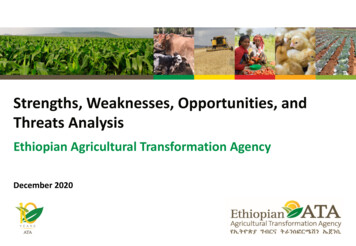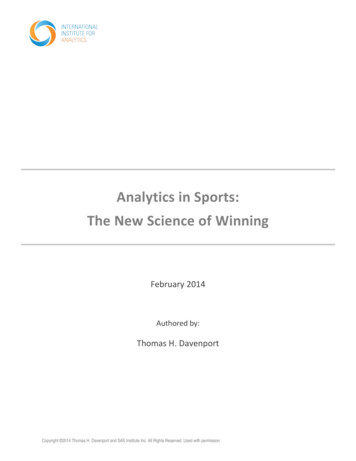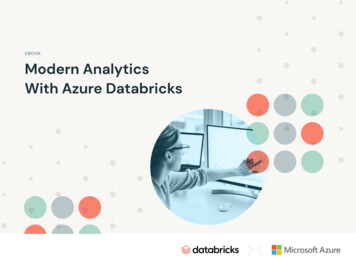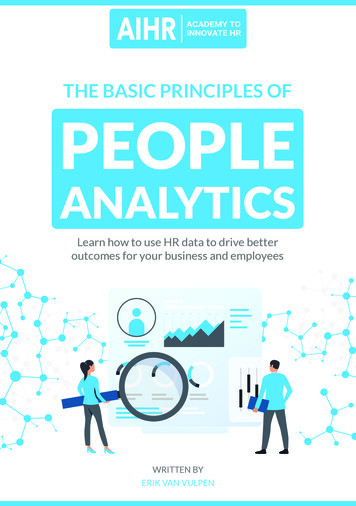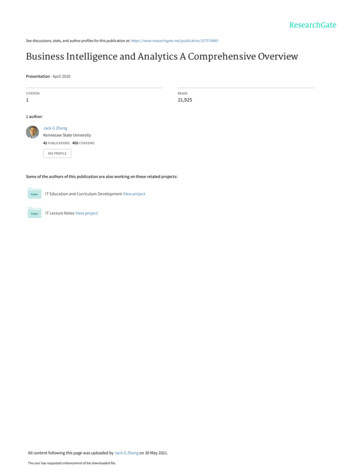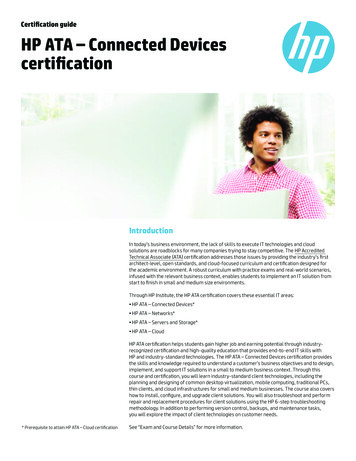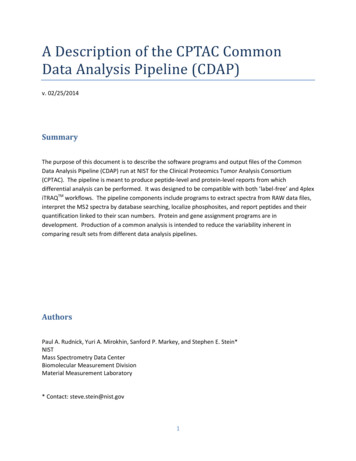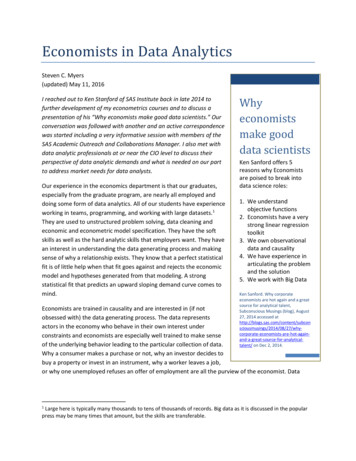
Transcription
Economists in Data AnalyticsSteven C. Myers(updated) May 11, 2016I reached out to Ken Stanford of SAS Institute back in late 2014 tofurther development of my econometrics courses and to discuss apresentation of his “Why economists make good data scientists.” Ourconversation was followed with another and an active correspondencewas started including a very informative session with members of theSAS Academic Outreach and Collaborations Manager. I also met withdata analytic professionals at or near the CIO level to discuss theirperspective of data analytic demands and what is needed on our partto address market needs for data analysts.Our experience in the economics department is that our graduates,especially from the graduate program, are nearly all employed anddoing some form of data analytics. All of our students have experienceworking in teams, programming, and working with large datasets.1They are used to unstructured problem solving, data cleaning andeconomic and econometric model specification. They have the softskills as well as the hard analytic skills that employers want. They havean interest in understanding the data generating process and makingsense of why a relationship exists. They know that a perfect statisticalfit is of little help when that fit goes against and rejects the economicmodel and hypotheses generated from that modeling. A strongstatistical fit that predicts an upward sloping demand curve comes tomind.Whyeconomistsmake gooddata scientistsKen Sanford offers 5reasons why Economistsare poised to break intodata science roles:1. We understandobjective functions2. Economists have a verystrong linear regressiontoolkit3. We own observationaldata and causality4. We have experience inarticulating the problemand the solution5. We work with Big DataKen Sanford. Why corporateeconomists are hot again and a greatsource for analytical talent,Subconscious Musings (blog), August27, 2014 accessed nd-a-great-source-for-analyticaltalent/ on Dec 2, 2014.Economists are trained in causality and are interested in (if notobsessed with) the data generating process. The data representsactors in the economy who behave in their own interest underconstraints and economists are especially well trained to make senseof the underlying behavior leading to the particular collection of data.Why a consumer makes a purchase or not, why an investor decides tobuy a property or invest in an instrument, why a worker leaves a job,or why one unemployed refuses an offer of employment are all the purview of the economist. Data1Large here is typically many thousands to tens of thousands of records. Big data as it is discussed in the popularpress may be many times that amount, but the skills are transferable.
Tell the storyrepresents the observations on purchases, but they come about because ofthe human behavior economics is able to model.Economists make good story tellers. Asking “why” and not just acceptingfacts as stated or statistically revealed is a type of occupational hazard foreconomists and a good one for employers. One of the former CIOs I spoketo expressed excitement that economists understood causality and thedata generating process, as his experience was most analysts do not.Understand theKnowing that data has revealed a correlation or trend as one might find ina statistical analysis does not explain why the correlation or trend exists. Itprocesses thatalso does not necessarily allow itself to be subject to other influences thatgenerated themay matter and that are not examined unless one is asking the “why”data.question. Additionally, the data is typically never clean as might beexperimental data or results of a quality control investigation. In fact,economists have to learn to deal with data that is observational andsubject to all sorts of dirtying influences. Harvard Economist, Zvi Griliches, once remarked that if itweren’t for dirty data, economists wouldn’t have jobs. This “dirty” data is to say that lots of influencesare in the data, that one must pay strict attention to the data generation process. Knowing the data welland understanding how it is generated allows an economist to fashion a model solution that cannot justforecast a trend or display a correlation, but to actually predict.Explain “Why”understandingthe causalityThe data analytic world speaks of predictive modeling and predictive accuracy, but this is not what aneconomist means by prediction. In the data analytic world a predictively accurate analysis would beconsidered by an economist as the result of a descriptive exercise. In such descriptive analysis, tools ofstatistical analysis are applied to data in order to mine the data, describe the data or model the patternsin the data. The data analyst so trained would seek a best fit and accurate representation of a next orfuture data point and provide for statistical significant results. When this analysis is done on time-seriesdata an economist refers to this as a forecast. Many economists do participate and excel in forecasting,but what makes an economist different from a statistician is not the statistical modeling, even thoughthe statistician may be more skilled at that, but that the economist first builds an economic model; amodel that explains “why.”A statistical model is not an economic model. Statistical significance is a necessary condition, but not asufficient condition for economic significance. The economist does use a statistical model, but theeconometrician uses it in context with causality and the DGP (data generating process), hereinafterreferred to as the econometric model.So the first step for the economist is to create an economic model of the actors from which the data isgenerated. So if retail point-of-sale transactions are being analyzed, the economist seeks to model thedemand of the consumer for the product and must also take into account the supply of product fromthe retail establishment. The economic model would apply economic theory of demand and supply andwould formulate hypotheses that would be expected to be seen in the data. Essentially the economist isconcerned not just with how many items were sold, but why were they bought? The economist is
modeling the casual relationships and this theory may be best thought of as a story. A story about whyconsumers come into a retail establishment and why they purchase an item or items whilesimultaneously considering the other influences on the decision such as the income of the consumers,other prices of complementary and substitutive goods, and more. Economists make good story tellers.What skills then do economists need to be data analysts? In a word they need to be trained ineconometrics; you want to hire an econometrician. These econometricians must be economists first,then statisticians, and finally computer programmers. What makes econometricians so valuable in dataanalysis is that they are highly competent in all three areas: economics, statistics and computerprogramming.But you don’t want to hire any econometrician, but you want one that is highly trained in appliedeconometrics. Theoretical econometricians and classically trained econometrician will have strong skillsin statistical inference. Statistical inference is the use of statistics to infer results and requires a classicaltraining in how to estimate results (such as correlations and regressions) and how to preform hypothesistesting (such as will sales next period statistically and significantly exceed last period). All economistswho have taken econometrics are trained in this classical inference of estimation and hypothesis testing.InferenceClassical econometricsEstimation techniquesHypothesis testing techniquesApplied econometricsProblem Articulation / Research HypothesisData finding / cleaning / managementModel SpecificationApplied econometrics goes well beyond the classical training in inference briefly discussed above. PeterKennedy (2011) describes the three pillars of applied econometrics as (1) problem articulation, (2) datacleaning, and (3) model specification. It is these three pillars that a CIO should seek to find amonghis/her data analysts. Applied econometricians offer all the three.The first of these is the ability of a researcher to deal with an unstructured problem and make sense outof it. As W. Lee Hansen observed, the highest level of learning is the ability to ask the right question. It isthe derivation of the question out of the unstructured problem that is a key asset of an appliedeconometrician. Put to use will be economic reasoning and a story will emerge as to how and why theeconomic agents behave. From the economic model will derive the hypotheses that will determine thatthe economic story is be “accepted” or rejected. It is from this model and understanding that causality ishypothesized and that an explanation of behavior including prediction is forthcoming.Kennedy refers to the second of these pillars as Data Cleaning. An unsatisfying term as economistsregard this as much more than mere cleaning of a dataset, but the wording is instructive in thateconomists regard all observational data as dirty. And dirty data will need cleaned. But more than that,it is important to understand the data generating process (DGP). Is the data non-random, censored,truncated, self-selected? Are relevant variables available or must proxies or instruments be used. Are
good instruments available? Among the variables prepared, are they exogenous or endogenous, and ifthe latter can the data support the system wide economic model.The third pillar of model specification requires the applied econometrician to build a model of availabledata variables that matches the theoretical model as articulated in the first step of problem articulation.Given the dirty nature of the data and the attempts to clean it, the model specification gives rise toother issues (some of which are a direct result of the DGP and the quality of the variables). Other issuescome directly from the nature of the problem as articulated, from the economic model itself. In thelatter case if there is known endogeneity of right hand side variables then this effects the modelspecification and hence the estimation and testing strategy.Economists as Data ScientistsEvidence from SAS’s Econometric EvangelistBackground for why economics must be a part of any data analytic effort!This is a list of YouTube and blog entries by Ken Sanford, SAS’s Econometric Evangelist, on how and whyeconomists make great data analysts.[1]Ken Sanford. Econometric reflections from Analytics 2014, Subconscious Musings (blog), Nov 3,2014 accessed at 14/ on Dec 2, 2014.Ken discusses various items, but the first is the most important and is his joint presentation with JanChvosta titles, “Why Econometrics Should Be in Your Analytics Toolkit: Applications of Causal Inference”(available at http://gozips.uakron.edu/ myers/E627/Sanford Ken Chvosta Jan A2014.pdf)Partial quote: “Of note to me was just how many audience members approached us afterward and saidthat ‘causal interpretation’ is what they strive for with their predictive modeling. From marketing mixmodels to CCAR stress testing to price elasticity estimates, I saw many nodding heads when we talkedthe importance of interpretation in these models. To twist the words of Nobel Laureate Robert Lucas,“once you start thinking about causality, it is hard to think about anything else.” It appears to me thatthere are still many people interested in the meaning of models in this world of ‘big data’ and ‘machinelearning.’”[2]Ken Sanford. Why corporate economists are hot again and a great source for analytical talent,Subconscious Musings (blog), August 27, 2014 accessed and-a-great-source-for-analytical-talent/ on Dec 2, 2014.In this video, Ken offers 5 reasons why Economists are poised to break into data science roles:1. We understand objective functions2. Economists have a very strong linear regression toolkit
3. We own observational data and causality4. We have experience in articulating the problem and the solution5. We work with Big Data[3]Ken Sanford. From Economists to Data Scientist: How our discipline can participate in thegrowth of analytics. Presentation to AIER. YouTube video (1:22:58), September 9, 2014.https://www.youtube.com/watch?v KlNkXCkUKAo accessed Dec 2, 2014.This important 83 minute video is very clear on how economists can become data scientists. Datascientists cover all the areas of data acquisition, data management and transformation, computationand reporting and visualization.He describes the reasons economists excel and then discusses the barriers to economists entering thedata analytic field. They include understanding the technology and the ability to speak with the jargonthat business understands. One example, a business many might want data “scored” and an economistwon’t understand until they learn it is in sample prediction.[4]Ken Sanford. Why econometrics is important for business analysis. Youtube Video (2:57) FromAnalytics 2013 http://youtu.be/ONzG8jJ0i5Y[5]Ken Sanford. Economists make Good Data Scientists. YouTube Video (1:29)http://youtu.be/WGvMARRid7w at Analytics 2014
Applied econometrics goes well beyond the classical training in inference briefly discussed above. Peter Kennedy (2011) describes the three pillars of applied econometrics as (1) problem articulation, (2) data cleaning, and (3) model specification. It is these three pillars that a CIO should seek to find among his/her data analysts.
